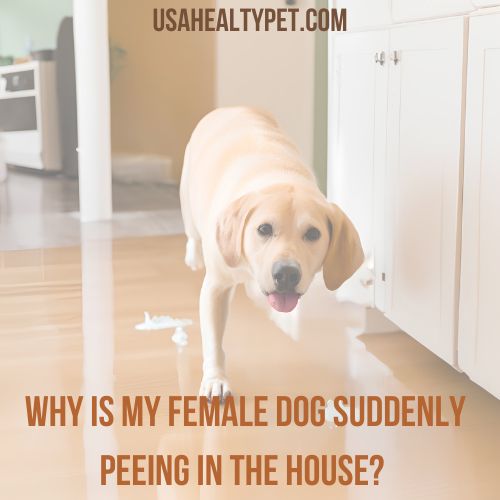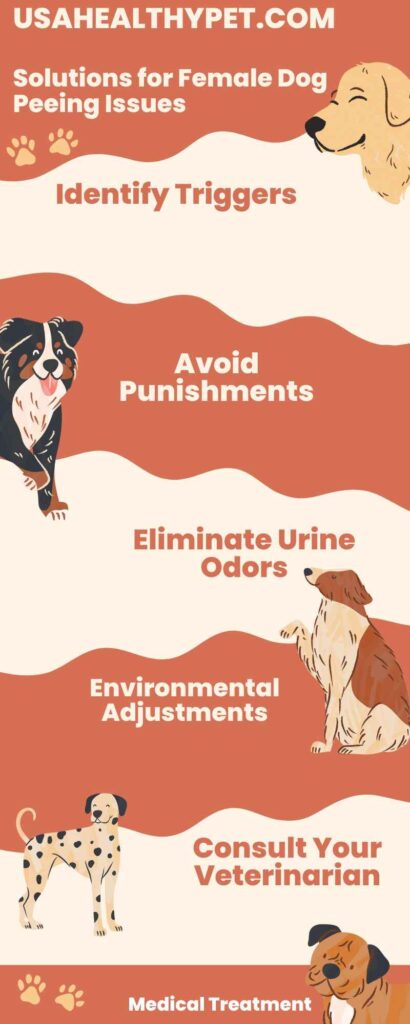If your house-trained female dog has suddenly started peeing in the house, it can be both puzzling and frustrating.
Understanding the possible causes and effective solutions is crucial for your dog’s well-being and your household’s harmony.
Let’s explore the potential reasons behind this behavior and how to address it effectively.
Common Causes of Female Dog Peeing in the House
1. Why My House-Trained Dog Started Peeing
When a house-trained dog starts peeing indoors, it’s a sign that something is amiss. This could be due to health issues, behavioral changes, or environmental factors. Identifying the root cause is the first step towards resolving the issue.
2. Incontinence Caused by Spaying
Spaying can sometimes lead to hormonal imbalances, causing incontinence in female dogs.
According to a study published in the Journal of Small Animal Practice, urinary incontinence occurs in approximately 5-20% of spayed female dogs.
This is relatively common and can usually be managed with medication.
Dr. Julie Buzby, a veterinarian, explains:
“Spay incontinence is relatively common and can usually be managed with medication.”
3. Caused by Behavioral Issues
Behavioral changes, such as anxiety or stress, can lead to inappropriate urination. Changes in the household, new pets, or even alterations in your routine can trigger this behavior.
Anxiety and stress can significantly disrupt a dog’s usual habits, including their bathroom routine.
Veterinary behaviorist Dr. Sophia Yin notes:
“Anxiety and stress can significantly disrupt a dog’s usual habits, including their bathroom routine.”
4. Caused by Urinary Tract Infections (UTIs)
UTIs are a frequent cause of sudden incontinence. Symptoms include frequent urination, discomfort, and sometimes blood in the urine.
Research published in Veterinary Record found that UTIs are responsible for urinary issues in about 14% of dogs presented to veterinary clinics.
UTIs can cause a dog to feel an urgent need to urinate, often leading to accidents indoors.

5. Bladder Stones or Crystals
Bladder stones or crystals can irritate the bladder, causing frequent and painful urination.
Bladder stones need prompt veterinary attention as they can be very painful and cause serious issues.
6. Hormonal Imbalances
Hormonal changes, particularly in spayed females, can lead to urinary incontinence.
Estrogen deficiency post-spaying is a common cause, and hormonal incontinence can often be managed with appropriate medication.
7. Medical Conditions
Conditions like diabetes, kidney disease, and Cushing’s disease can increase urination frequency.
Regular vet check-ups are essential for early diagnosis.
Sudden changes in urination habits warrant a thorough vet examination to rule out underlying health issues.
8. Caused by Age-Related Conditions
Older dogs may suffer from cognitive dysfunction or weakened bladder muscles, leading to incontinence.
Aging can bring about various health challenges, including incontinence due to cognitive decline or weakened muscles.
Studies published in Veterinary Clinics of North America: Small Animal Practice indicates that cognitive dysfunction affects about 14% of dogs over the age of 8.
Solutions for Female Dog Peeing Issues at Home

1. House Training
Reinforcing house training can help remind your dog of the expected behavior. Positive reinforcement and patience are key.
- Tip: Use treats and praise when your dog pees outside.
2. Identify Triggers
Identifying and mitigating triggers that cause anxiety or stress can help reduce inappropriate urination.
This might involve changes in the household environment or addressing specific stressors.
- Tip: Keep a journal to track your dog’s behavior and identify potential triggers.
3. Avoid Punishments
Punishing your dog for accidents can increase anxiety and worsen the behavior.
Positive reinforcement and calm handling are more effective.
Avoid punishments as they can lead to more anxiety-related issues.
4. Behavioral Training
Working with a professional dog trainer or a veterinary behaviorist can address deeper behavioral issues.
Training can help your dog cope with stressors and reinforce proper bathroom habits.
- Tip: Consistency is key in behavioral training.
5. Environmental Adjustments
Creating a calm and stable environment can reduce anxiety and help manage behavioral issues.
This includes providing a designated safe space for your dog and maintaining a consistent routine.
- Tip: Use calming aids such as pheromone diffusers.
6. Manage Age-Related Issues
For older dogs, using doggy diapers or incontinence pads can manage accidents.
Regular vet visits and appropriate medications can help address age-related health issues.
Older dogs might need more frequent bathroom breaks and additional care to manage incontinence.
Dr. Ward advises:
“Older dogs might need more frequent bathroom breaks and additional care to manage incontinence.”
7. Eliminate Urine Odors
Thoroughly cleaning areas where accidents have occurred can prevent repeat incidents. Enzymatic cleaners are particularly effective in removing urine odors.
- Tip: Clean accidents immediately to prevent lingering odors.
8. Consult Your Veterinarian
Always start with a vet consultation to rule out medical issues.
A thorough examination, including urine tests and blood work, can identify the cause and guide treatment.
Veterinary consultation is crucial for diagnosing the underlying cause of sudden incontinence.
9. Medical Treatment
Depending on the diagnosis, treatment might include antibiotics for UTIs, special diets for bladder stones, or hormone therapy for spay incontinence.
Follow your vet’s treatment plan closely for the best results.
- Tip: Keep a medication schedule to ensure consistency.
Conclusion
Understanding why your female dog is suddenly peeing in the house involves identifying the root cause, whether it’s medical, behavioral, or environmental.
With the guidance of your veterinarian and appropriate training and adjustments at home, you can help your dog return to her house-trained habits.
Remember, patience and consistency are key in managing and resolving incontinence issues.
By addressing the causes and implementing the solutions outlined above, you can ensure your dog’s health and happiness, restoring peace to your home.
Pingback: Can Dogs Eat Cream of Mushroom Soup? Experts Guide
Pingback: Why Is My Dog's Poop Orange After Eating Chicken and Rice?